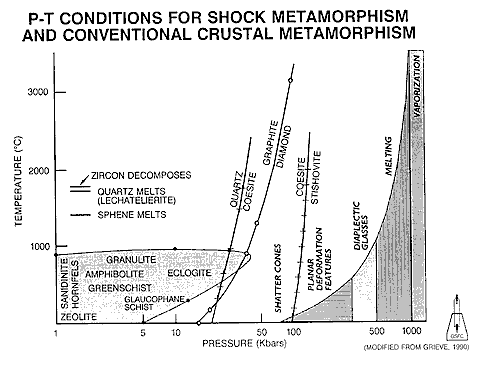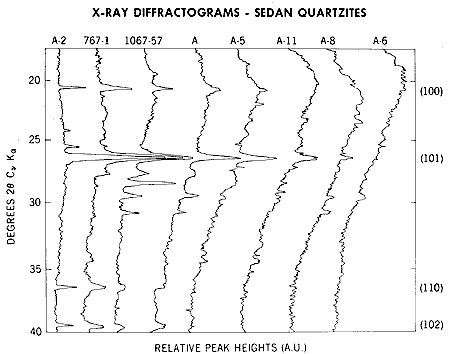

The P-T field (as facies) for conventional metamorphism is shown
in the lower left. Pressure and heat generated by the shock waves
transform the crystal structures of individual minerals in spectacular
ways. One diagnostic transformation is that of the common mineral
quartz to a high-pressure phase called coesite. At even higher
pressures another form of SiO2 known as stishovite can be generated although it may be unstable
at high temperatures. Planar deformation features (see below) develop over a wide range of pressures. At even higher
pressures, crystals may undergo atomic-structural displacements
that convert them to glasses without passing through a melt stage.
These diaplectic glasses usually retain their original shapes (e.g., grains),
giving rise to forms known as thetomorphs. The photo below shows a small hand specimen of granite collected
among the ejecta from the Sedan nuclear cratering explosion (100
kiloton device) within alluvium at the Nevada Test Site. This
specimen is now completely composed of glass thetomorphs in which
the individual crystals (including the larger 6-sided phenocryst
of feldspar) have remained intact without any melt-like internal
flow.
Shock metamorphism is progressive, that is, the effects increase
or change in style as shock pressures increase. This is evident
in this series of X-ray spectrometer diffractograms made from
Cu K-alpha radiation on powder mounts of material extracted from
eight quartzite samples collected as ejecta from the Sedan nuclear
cratering explosion.

The peak pressures acting on each sample are unknown. The strip
chart record for each sample has been redrawn by arranging the
sequence shown from left to right in the order of increased shock
damage based on other criteria. Peaks near 20, 27, 36, and 39°
represent quartz reflection planes (crystal indices on right);
those near 28, 29, and 31° are associated with feldspars. The
peak at 27° (101 plane) is especially sensitive to degree of crystal
structure integrity. As the level of shock damage increases, peak
height diminishes as this structure undergoes progressive disorganization,
beginning in the quartz with development of microfractures (samples
A-2 and 767-1) and proceeding to the diaplectic glass stage (samples
A-8 and A-6) at which the crystal structure becomes extremely
disordered.
Shock metamorphic effects are best seen in thin sections (thin slices of rock ground to a thickness of 0.03 mm) under a petrographic microscope. In the next 11 illustrations, these features are presented as photomicrographs. If the sample is being viewed in plane polarized light, the symbol PP will be included in parentheses; otherwise, if no symbol is added, the section is being viewed in cross-polarized light.
One unique change results from submicroscopic breakdown and slip
along crystal planes to produce planar deformation features (PDFs),
exemplied in quartz and in feldspar - two very common rock-forming
minerals - as viewed in thin section under a petrographic microscope.
Shown on the top (PP) are decorated (darkened by tiny bubbles)
PDFs in quartz within a granitic rock recovered as core from the
Manson structure. Shock damage may so intensive as to induce a
brown discoloration, called "toasting", as seen (bottom; PP) in
this cluster of quartz crystals (interpreted by the writer as
caused by shattering of a single crystal in this granite clast
from Manson).
Multiple sets of undecorated PDFs in quartz abound within a sandstone
(top) (PP)
involved in the Sedan nuclear cratering event. When
a slice of shocked rock is etched by HF acid, silicate material
within PDFs is selectively removed leaving a gap. On the bottom
is a quartz grain from a Sedan sandstone as examined at high magnification
under an electron microscope that confirms this removal, suggesting
PDFs consist of disordered SiO2 converted to glass that is more susceptible to etching; note
that the PDFs are indeed remarkably planar.
In the next pair of photomicrographs, on the top is a single set
of PDFs arranged en echelon (slanted) in alternate twins within
a soda-feldspar crystal in granitic rock from Manson. On the bottom,
feldspar within a granite at the Carswell Lake (Canada) impact
structure has been strongly "kinked" (these are also referred
to as deformation lamellae):
The micaceous mineral biotite, which consists of very thin cleavages
stacked like pages in a book, is also easily kinked as shown on
the top below for a sample of granite subjected to a nuclear explosion
(PP). As pressures enter the 400 kilobar range, feldspar in a
Manson granite has begun to melt as shown at the bottom by dark
and gray flow bands but the rock remains intact (quartz still crystalline).
At more extreme pressures, mineral grains may be converted into
glass without any change in the original shapes, i.e., the texture
is preserved while the composition changes from crystalline to
glassy. These thetomorphs are shown in a microscope view (PP)
for grains of quartz in a sandstone collected from around the
Sedan nuclear crater at the Nevada Test Site; SiO2 appears to be undergoing incipient vaporization as indicated
by the occasional round vesicles.
At pressures within the 400-500 kilobar range, rocks will melt as
though severely heated (above about a half megabar, rock will start to vaporize).
The melt quickly quenches into glass and may end up as singular
masses mixed in the breccias or as discrete layers near the bottom
of the final crater. On the top is a microscope view (PP) of the
breccia (called suevite locally)
from the Ries crater in Bavaria that contains both shock-melted rock (brown flow bands) and occluded
fragments of quartz with PDFs. On the bottom is a melt from the
Manicouagan (Quebec) crater whose composition is close to that
of feldspar in which crystals of feldspar have grown in place
rapidly as the melt was quenched.
Thetomorphs and the types of PDFs shown above occur in nature only within rocks involved in structures that have at least some of the characteristics of impact craters. They are also readily formed in rocks surrounding nuclear explosions at which pressures are directly measured by instruments in the hundreds of kilobars range. And, they can be made experimentally in the laboratory by controlled explosions in these pressure ranges, as in the implosion tube method invented by the writer. They are not present as such in breccia rocks associated with volcanic explosions, where pressures rarely exceed 10 kb. Their presence is decisive proof of an impact event as the cause of a deformed structure.
Code 935, Goddard Space Flight Center, NASA
Written by: Nicholas M. Short, Sr. email: nmshort@epix.net
and
Jon Robinson email: Jon.W.Robinson.1@gsfc.nasa.gov
Webmaster: Bill Dickinson Jr. email: rstwebmaster@gsti.com
Web Production: Christiane Robinson, Terri Ho and Nannette Fekete
Updated: 1999.03.15.